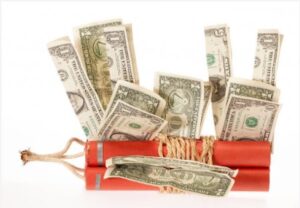Hyperinflation Can Happen Much Faster than You Think
The comments below are an edited and abridged synopsis of an article by James Rickards
In the US, the Fed has expanded the base money supply by over $6 trillion since 2008, with over $3 trillion of that coming since last February.
But the velocity of money has been decreasing, so inflation isn’t a problem—yet. Banks have not been lending much, and consumers haven’t been spending much of the new money. It’s just sitting in the banks.
Money printing turns into inflation, and then hyperinflation, when consumers and businesses lose confidence in price stability and see more inflation on the horizon. At that point, money is dumped in exchange for current consumption or hard assets, thus increasing velocity.
As inflation velocity spikes, expectations of more inflation grow, and the process accelerates. In extreme cases, consumers will spend their entire paycheck on gas, gold and groceries the minute they receive it.
They know that holding on to cash will result in it being wiped out. The point is that hyperinflation is not just a monetary phenomenon; it’s a psychological/behavioural phenomenon.
Hyperinflation doesn’t affect everyone in a society equally. There are winners (who have gold, foreign currency, land and other hard assets) and losers (who have fixed income claims, savings, pensions, insurance policies and annuities).
Debtors win in hyperinflation because they pay off debt with debased currency. Creditors lose because their claims are devalued.
A hyperinflation as in Weimar Germany could easily happen again. Consider America in the late 1970s: The US dollar suffered a 50% inflation from 1977–1981. It was heading for hyperinflation, relatively close to where Germany was in 1920. It was prevented by the combined actions of Ronald Reagan and Fed Chair Paul Volcker, but it was a close call.
Today the Fed assumes that if inflation moves up to 3% or more, it can dial it back to the preferred 2% target. But moving inflation to 3% requires a huge change in the behaviour and expectations of Americans. That change is not easy to cause, and once it happens, it is even harder to reverse.

